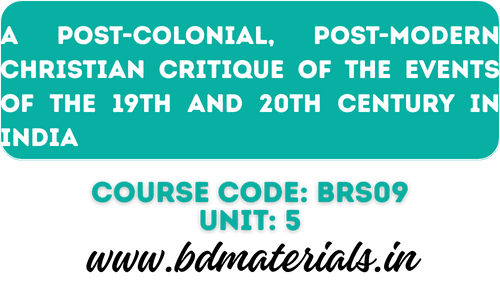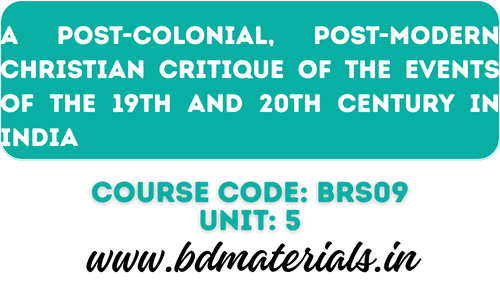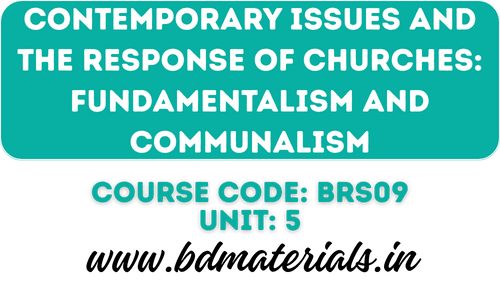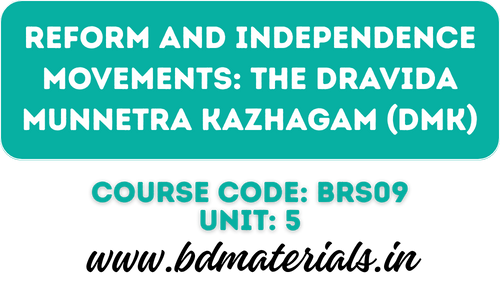Reform and Independence Movements: DALITS
A Dalit is not considered to be part of the human society, but something, which is beyond that. The Dalits perform the most menial and degrading jobs. Sometimes Dalits perform important jobs, but this is mostly not socially recognised. Dalits are seen as polluting for higher caste people. If a higher caste Hindu is touched by an untouchable or even had a Dalit’s shadow across them, they consider themselves to be polluted and have to go through a rigorous series of rituals to be cleansed. In India there are approximately 240 million Dalits. This means that nearly 25% of the population is Dalit. It also means that in a country, where everybody is supposed to have equal rights and opportunities, 1 out of 4 persons is condemned to be untouchable.
In general one can say that being a Brahmin means that you are more privileged. This can imply having a good education and, accordingly, a more powerful position in the society. Being born as a Dalit you will be less well off and because of less education you will have a less good job. In daily life there are a lot of consequences of being a Dalit.
Dalits are poor, deprived and socially backward. Poor means that they do not have access to enough food, health care, housing and/or clothing (which means that their physiological and safety needs are not fulfilled). They also do not have access to education and employment. With deprived we would like to underline the injustice they face in every days life. Officially, everybody in India has the same rights and duties, but the practice is different. Social backwardness, lack of access to food, education and health care keeps them in bondage of the upper castes.
Dalit does not mean low caste. Dalit does not mean any religion. Dalit refers to some unique people with distinct culture and traditions.
But how did they lose their identity and their uniqueness?
“Every hour – two dalits are assaulted, every day three – dalit women are raped and two dalits are murdered ….two dalit houses are burnt.” (Human Rights Education Movement in India)
A Dalit is not only forbidden to enter the home of a Brahmin but he must also not draw water from the same well, not eat from the same pot or place. He must not glance at or allow his shadow to fall on the Brahmin. All these acts will pollute the “pure Brahmin.”
Origin of The Word Dalit
The term ‘Dalit’ has roots in Sanskrit where the root ‘dal’ means ‘to split, crack, open’. ( This Indo-European root appears in German and English in the form of ‘dal’ or ‘tal’, meaning ‘cut’. In English, ‘dale’ is a valley, a cut in the ground; in German, ‘thal’: a tailor is one who cuts; ‘to tell a tale’ is the same as ‘to cut a tally’, the cut-marks made by the shepherd on his staff when counting sheep.
‘Dalit’ has come to mean things or persons who are cut, split, broken or torn asunder, scattered or crushed and destroyed. By coincidence, there is in Hebrew a root ‘dal’ meaning low, weak, poor. In the Bible, different forms of this term have been used to describe people who have been reduced to nothingness or helplessness.The present usage of the term Dalit goes back to the nineteenth century, when a Marathi social reformer and revolutionary , Mahatma Jyotirao Phule (1826-1890), used it to describe the Outcastes and Untouchables as the oppressed and the broken victims of our caste-ridden society. Under the charismatic leadership of Dr. B.R. Ambedkar (1891- 1956), this term gained greater importance and popularity. During the 1970s, the followers of the Dalit Panther Movement of Maharastra gave currency to the term ‘Dalit’ as a constant reminder of their age-old oppression, denoting both their state of deprivation and the people who are oppressed. This term for them is not a mere name or title: for them it has become an expression of hope, the hope of recovering their past self-identity. The term has gained a new connotation with a more positive meaning. It must be remembered that Dalit does not mean Caste or low-Caste or poor ; it refers to the deplorable state or condition to which a large group of people has been reduced by social convention and in which they are now living.
Caste System
One of the more confusing mysteries of India is its caste system. The caste system, which has existed already for more than 3000 years, has been developed by the Brahmins (priests) in order to maintain their superiority. Eventually, the caste system became formalised into 4 distinct classes (Varnas).
At the top are the Brahmins, the priests and arbiters of what is right and wrong in matters of religion and society. Next come the Kshatriyas, who are soldiers and administrators. The Vaisyas are the artisan and commercial class, and finally, the Sudras are the farmers and the peasant class. These four castes are said to have come from Brahma’s mouth (Brahmin), arms (Kshatriyas), thighs (Vaisyas) and feet (Sudras).
Beneath the four main castes is a fifth group, the Scheduled Caste. They literally have no caste. They are the untouchables, the Dalits, which means oppressed, downtrodden and exploited social group.
Names Of The Dalits
The Dalits are called by different names in different parts of the country. These names were given by the Caste people as expressions of contempt. They include: Dasa, Dasysa, Raksasa, Asura, Avarna, Nisada, Panchama, Chandala, Harijan, Untouchable. Each of these names has a history and background. Besides these names, there are a number of other titles or names which have been given to them at the level of the regional language. For example, Chura in Punjab (North West India), Bhangi or Lal Beghi in Hindi (North India), Mahar in Marathi (Central India), Mala in Telugu, Paraiya in Tamil and Pulayan in Malayalam (South India). These names carry within them the two-term contrast of “we-the pure” and “you-the impure”. In response to these insulting labels, the Untouchables have chosen to give themselves a name and this is ‘Dalit’, which refers to the hardship of their condition of life. This name is a constant reminder of the age-old oppression. The term is also an expression of their hope to recover their past self-identity. If today the Dalits are reduced to a life of abject poverty and treated as polluted human beings, it is the non- dalit that must be seen as the agent of their dehumanisation. By the British, the Dalits were named ‘the Depressed Classes’ and ‘the Scheduled Castes’, in the Scheduled Caste Act of India, 1935. Mahatma Gandhi named them ‘Harijans’ which means ‘children of God’ : but this term was not welcomed by the Dalits because it did not adequately describe their condition.
Atrocities in Dalits’ Daily Lives
The oppression of Dalits has occurred for the past 3,000 years. They are segregated in all spheres of social life: in places of worship, education, housing, land ownership, use of common property resources such as wells and village water taps, roads, buses and other public places. They are the people who are made to do all menial and degrading jobs in our society. They are considered to be untouchable, to be too ‘polluted’ to touch. In their daily lives, untouchability results in, among other things, the following consequences:
- In many dominant caste (rich) families, the servants are Dalits. After a Dalit servant has cleaned the rooms, pots and pans, one of the family members will sprinkle ‘holy water’ around the house to purify all that has been touched by the Dalit servant.
- Dalits are not allowed to wear shoes; if they wear shoes, they will be forced to take them off when coming into the presence of a dominant caste person.
- In rural areas, Dalits are not allowed to cycle through the dominant caste area of the village. Dalits live mainly in separate communities, outside the actual village.
- In general, Dalits are not allowed to sit at bus stops; they have to stand and wait until dominant caste people have entered onto the buses. Dalits are also not allowed to sit on the bus seats, even if they are vacant.
- Dalits are not allowed to enter many Hindu temples, for fear of their polluting the temples. Dalits have been chased out, abused and beaten up for daring to as much as set foot inside a temple, even though it is a temple for their religion.
- After half a century of Independence, even many educated Dalits continue to face discrimination in renting a house to live in.
- Most Hindus will avoid having a Dalit prepare their food, for fear of becoming polluted.
- Dalits have been systematically attacked or socially boycotted for asserting their basis rights to land, minimum wages, education, housing, food, water, etc.
A Survey Of Indian Religions
Some embraced Sikhism, Buddhism, Islam or Jainism. The Dalit Christians, of course, are those who embraced Christianity. Apart from the supernatural aspects of the Christian faith, one human factor may well have been the hope of rising to a measure of equality with others and of attaining some measure of human dignity in this world. In their transition to a new identity, this hope has been realised to some extent but not totally. The roots of casteism are deep: casteism pervades all walks of life, even the realm of religion. In practice, the Dalits remained ‘Dalits’ regardless of religion. A Dalit is a Dalit whether he is a Hindu or a Muslim or a Buddhist or a Christian. Even as members of various Christian communities, Christan Dalits suffer the same ancient segregation, oppression and unjust discrimination, the same social, educational and economic disabilities, only now at the hands of their fellow Christians of the upper castes. Conversion into the new faith has not redeemed them from their ‘dalitness’, the stigma of ‘Untouchablity’. Dalit and untouchable they have remained, even within the Christian communities. Among the 25 million Christians in India, 20 million are Dalits: the Dalits constitute the vast majority of the Christians.
A View of the Indian Religions
| Religion | Population (Millions) | Percentage |
|---|---|---|
| HINDUISM | 800 | 80% |
| ISLAM | 140 | 14% |
| SIKHISM | 20 | 2% |
| BUDDHISM | 8 | 0.8% |
| CHRISTIANITY | 25 | 2.5% |
| JAINISM | 4 | 0.4% |
| OTHERS | 3 | 0.3% |
Current Statistics of Dalits According to their Religion
20% of the Indian population is considered to be of Dalit origin. This means that there are 200 million people who belong to the Scheduled Castes. They practise different religions. In addition to this 20% who are in the Scheduled Castes, there is a further 10% of the Indian population who are categorized as the Scheduled Tribes, making a total of 30% who are outside the main stream of the population of India.
| Religion | Population | Percentage |
|---|---|---|
| Hindus | 140 Millions | 70% |
| Muslims | 15.5 Millions | 7.75% |
| Christians | 19 Millions | 9.5% |
| Sikhs | 15 Millions | 7.5% |
| Buddhists | 7.5 Millions | 3.75% |
| Jains & Others | 3 Millions | 1.5% |
The Constitution of India declares that India is a secular state and that every person has a right to practice any religion. For many years, the Christian Dalit communities have been appealing to the Government of India to cease discriminating against them on the basis of their religion and to restore their legitimate rights.
Friendly Note
Bachelor of Divinity Materials is your go-to resource for comprehensive Biblical studies, supporting students in Bachelor of Divinity (B.D.) and other theological courses. Our platform offers access to the full syllabus, detailed answers, and a vast collection of assignments, study guides, articles, and research papers to help you excel academically.
We provide downloadable PDFs of study materials, including books and journals, for convenient learning anytime, anywhere. Whether preparing for exams or conducting research, our resources cater to both students and scholars in biblical studies.
Committed to empowering theological learners, we aim to deliver high-quality, authentic study materials. Explore Bachelor of Divinity Materials to deepen your understanding of God’s Word and Christian doctrine, making it a valuable resource for aspiring ministers and anyone dedicated to theology.






